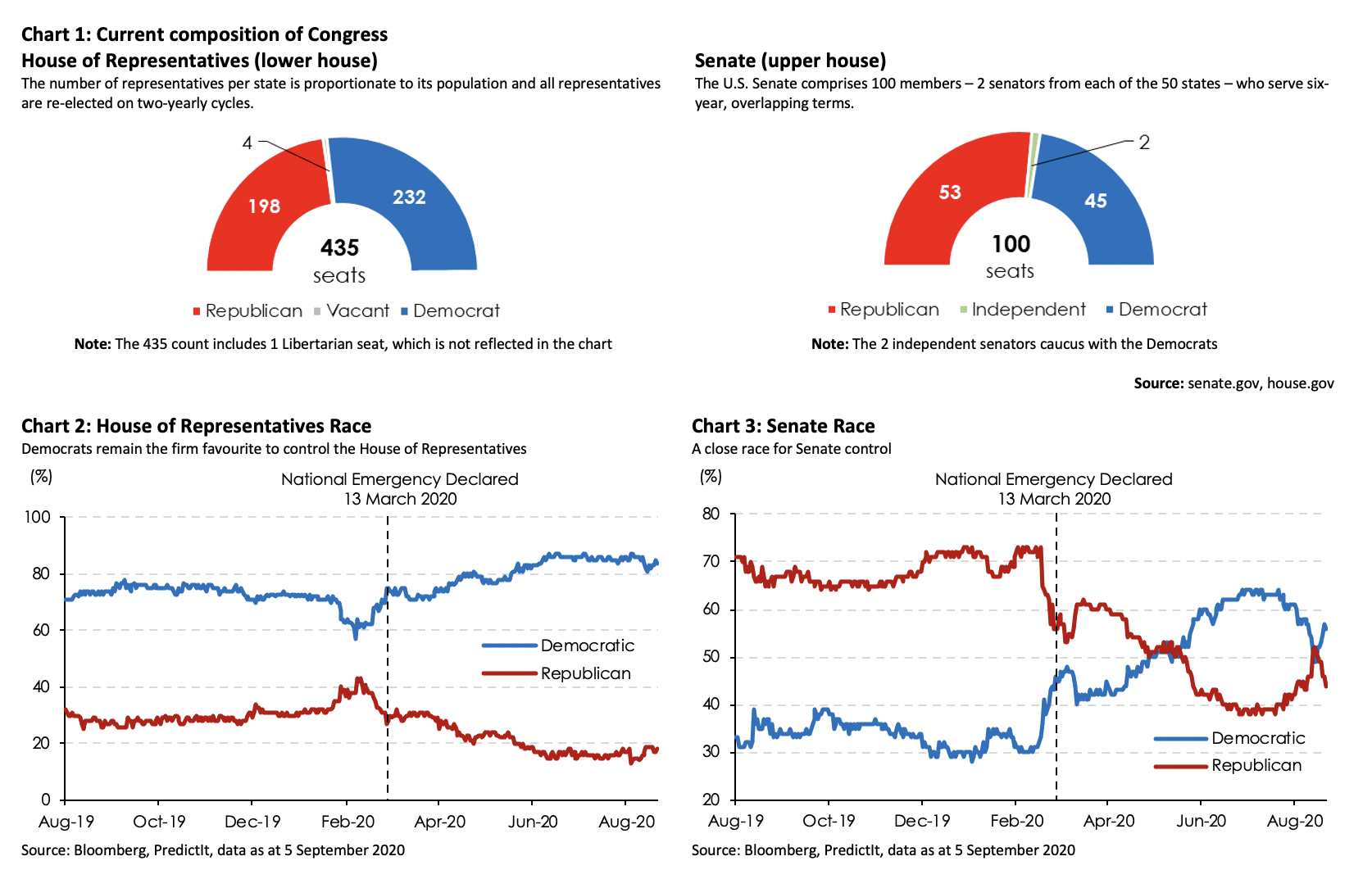The lowdown before the showdown
Congress matters for the markets
Beyond the choice for president, Americans will also be deciding the composition of Congress in November. It’s important to note that fundamentally, the US’ political system is defined by a separation of powers namely the executive (White House), legislative (Congress) and judicial (Courts). These branches of government are held in balance by a structure of checks and balances to ensure that no individual can wield unfettered power, as the founding fathers had intended.
Congress, a key source of checks and balances to the office of the President, is made up of two chambers, namely the House of Representatives (lower chamber) and the Senate (upper chamber).
The control of Congress is particularly important because it determines the ability of the next President to enact his or her policy agenda. While the president has immense latitude to influence trade and foreign policy, policies impacting the government budget like taxation and fiscal spending requires congressional support for legislation. As such, the office of the President – the executive branch – needs to cooperate and work closely with Congress – the legislative branch – to pass consequential policies. One cannot operate successfully without the support of the other.
In this context, Congress is a useful buffer between the president’s policy goals and aspirations and the real economy. Typically, negotiations in Congress leads to watered down bills such that the final legislation tends to be a more moderated version of the initial vision. As such, investors should not measure market prospects based on the raw proposals they hear during the course of campaigning.
Cooperation is easier if both the executive and legislative branches of government held the same economic and political beliefs or put simply, came from the same political party. That is why a clean sweep of the election by a single political party (i.e. the party controls the House, the Senate and the White House) typically portends big policy changes ahead.
Congress has also been the focus of ire over the years as frequent gridlocks and partisan politics have decreased public confidence in the government’s ability to enact effective policies. These widespread frustrations have led to the rise of support for less conventional Presidential candidates such as the incumbent, President Donald Trump, and Senator Bernie Sanders.
Blue House
While not either party’s chosen official colours, the Republican Party is normally represented by red, while blue represents the Democratic Party.
As it stands, the Democrats control the House of Representatives while the Republicans control the Senate.
All 435 seats in the lower house are up for election this year while 35 of the 100 Senate seats are up for election, 23 of them currently held by Republicans and the remaining 12 by Democrats.
The Democrats need to win 218 seats in the House to preserve their majority. By and large, they are expected to retain control of the House of Representatives this election cycle. Prediction markets have priced very strong odds of this happening come November.
Blue Senate?
The big story is whether the Democratic Party will be able to wrest control of the Senate from Republican clutches.
Republicans must retain 21 seats to guarantee a majority while the Democrats need minimally 15, which may include retaining all 12 Democratic seats up for re-election and flipping 3 (assuming Joe Biden wins the election as the vice president casts tie-breaking votes) to 4 Republican seats.
Winning over existing Republican seats tends to be more difficult than defending incumbency, which might explain why prediction markets had initially priced in a low probability of the Senate turning blue. In addition, a buoyant economy prior to the pandemic offered little impetus for voters to consider an alternative choice for the upcoming Senate race.
However, the unprecedented economic shock stemming from the coronavirus pandemic and President Trump’s wavering favourability in the polls starkly improved Democrats’ relative electoral position, increasing the probability of a Democrat-controlled Senate come November. As a result, prediction markets have priced in better odds for the Democrats to assume control of the Senate.
Yet, the economic recovery and easing coronavirus infections have also improved President Trump’s chances, eating into the Democrats’ lead.
As it stands, the race for the senate remains close and highly uncertain. A Democrat-controlled Senate is certainly not out of the realm of possibility in the event of a “wave election” in which a landslide Biden victory cascades down ballot.
Seats up for election
- All 435 seats in the lower house are up for election this year while 35 of the 100 Senate seats are up for election.
- 23 of Senate seats in play are currently held by Republicans and the remaining 12 by Democrats.
- The big story is whether the Democratic Party will be able to gain control of the Senate.
Republicans must win at 21 seats to guarantee a majority while the Democrats need to win minimally 15 (assuming Joe Biden wins the election as the vice president casts tie-breaking votes).

The road to 270: It’s not a popularity contest
Interestingly, while the Presidential election on 3 November determines the winner of the popular vote, this result is not necessarily binding - the winner of the popular vote may not become the President of the United States. To win the Presidency, the candidate must win the Electoral College.
Here is a short overview of the Electoral College process:
- On 3 November, Americans will go to the polls in their respective states, but they do not directly elect the President. Instead they elect representatives known as "electors", who usually pledge to vote for a particular presidential candidate. For example, an elector from the Republican Party would, under normal circumstances, vote for the Republican Presidential nominee. Although no elector is required by federal law to honour a pledge, there have been several occasions when electors voted contrary to a stated pledge.
- These electors are usually state-elected officials, party leaders or people in the state who have a personal or strong political affiliation with a candidate and are nominated by the respective political parties prior to the general election on 3 November.
- Electors are apportioned to each of the 50 states as well as the District of Columbia (also known as Washington, DC) according to the number of members in the state’s Congressional delegation. This is the sum of members in the House of Representatives plus the two members in the Senate. The District of Columbia is allocated three Electoral College votes.
- Most states operate a winner-takes-all system which awards all of the state’s Electoral College votes to the winning Presidential candidate of the state’s election, with the exceptions of Maine and Nebraska which operate a proportional system.
- These 538 electors (corresponding to 435 Representatives and 100 Senators plus 3 additional electors from the District of Columbia) will meet in December to vote for the next President of the United States. The ballots are opened, counted, and certified in a joint session of Congress in early January.
- A majority of 270 electoral votes is required to elect the President and Vice-President who will then take the oath of office with a ceremonial inauguration on 20 January in the year following the election.
Typically, the winner of the popular vote goes on to win the Electoral College. However, there were six instances in the long history of US presidential elections where the elected president did not win the popular vote but won the Electoral College.
The latest president to join this rarefied club is President Donald Trump in 2016. Before him, the most recent case was in 2000 (the other three cases occurred in the 1800s, which speaks to the rarity of such an incident), when George W Bush was declared the winner of the Electoral College and became the 43rd president even though he did not win the popular vote. On aggregate, Al Gore, his Democratic opponent, garnered about 540,000 more votes than he did but lost the Electoral College vote, 266 to 271.
Based on the weights of different states in the Electoral College, there are a number of swing states that could tip the election. Traditionally, these include Florida, Ohio and Pennsylvania.
The information provided herein is intended for general circulation and/or discussion purposes only. It does not take into account the specific investment objectives, financial situation or particular needs of any particular person. The information in this document is not intended to constitute research analysis or recommendation and should not be treated as such.
Without prejudice to the generality of the foregoing, please seek advice from a financial adviser regarding the suitability of any investment product taking into account your specific investment objectives, financial situation or particular needs before you make a commitment to purchase the investment product. In the event that you choose not to seek advice from a financial adviser, you should consider whether the product in question is suitable for you. This does not constitute an offer or solicitation to buy or sell or subscribe for any security or financial instrument or to enter into a transaction or to participate in any particular trading or investment strategy.
The information provided herein may contain projections or other forward looking statement regarding future events or future performance of countries, assets, markets or companies. Actual events or results may differ materially. Past performance figures are not necessarily indicative of future or likely performance. Any reference to any specific company, financial product or asset class in whatever way is used for illustrative purposes only and does not constitute a recommendation on the same. Investments are subject to investment risks, including the possible loss of the principal amount invested.
The Bank, its related companies, their respective directors and/or employees (collectively “Related Persons”) may or might have in the future interests in the investment products or the issuers mentioned herein. Such interests include effecting transactions in such investment products, and providing broking, investment banking and other financial services to such issuers. The Bank and its Related Persons may also be related to, and receive fees from, providers of such investment products.
No representation or warranty whatsoever (including without limitation any representation or warranty as to accuracy, usefulness, adequacy, timeliness or completeness) in respect of any information (including without limitation any statement, figures, opinion, view or estimate) provided herein is given by OCBC Bank and it should not be relied upon as such. OCBC Bank does not undertake an obligation to update the information or to correct any inaccuracy that may become apparent at a later time. All information presented is subject to change without notice. OCBC Bank shall not be responsible or liable for any loss or damage whatsoever arising directly or indirectly howsoever in connection with or as a result of any person acting on any information provided herein.
The contents hereof may not be reproduced or disseminated in whole or in part without OCBC Bank's written consent. The contents are a summary of the investment ideas and recommendations set out in Bank of Singapore and OCBC Bank reports. Please refer to the respective research report for the interest that the entity might have in the investment products and/or issuers of the securities.
This advertisement has not been reviewed by the Monetary Authority of Singapore.
Cross-Border Marketing Disclaimers
Please click here for OCBC Bank's cross border marketing disclaimers relevant for your country of residence.





